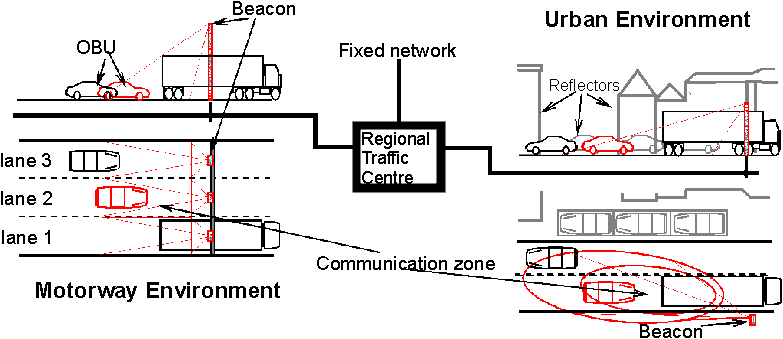
 |
JPL's Wireless Communication Reference WebsiteChapter: Network Concepts and Standards
|
In order to increase the efficiency and safety of the traffic, new concepts and technologies for a future Integrated Road Transport Environment (IRTE) are currently developed and implemented in various national and international Research & Development Programmes (e.g. Telematics Application Programme/Europe and ITS/North America). Both wide-range (e.g. based on RDS/TMC and GSM) as well as short-range vehicle-roadside communications are investigated with regard to their capability to support various RTTT services [10]. Many ITS- applications require an extremely high system reliability, especially those having an impact on safety (such as automatic cruise control) and those related to financial transactions (Automatic Fee Collection). Due to the influence of the constantly changing environment and the harsh real-time requirements, the development a reliable wireless communications subsystem is an important task in the design process for ITS systems.

Figure 1: Possible implementation scenarios for DSRC systems
Vehicle-roadside communication systems as part of the IRTE [2] are very well suited to support a decentralized system approach, where data is distributed and collected in a local environment. They are able to provide a reliable, mobile communication link between vehicles and a roadside infrastructure in free traffic flow using low-cost on-board equipment (OBE). Due to the short communication zones, the exact position of the vehicles can be determined. Typical RTTT services, which require communication between vehicles and the roadside together with accurate localisation information, are: Automatic Fee Collection (AFC), Traveller & Traffic Information, Dynamic Route Guidance (DRG), Fleet Management, Access Control and Parking Management. Figure 1 shows a possible implementation scenario with installations on motorways as well as in urban environments.
For the development of high-performance communication protocols and
the optimal selection of system components a number of requirements
and constraints resulting from different applications and
system environments have to be taken
into account: e.g. the amounts of data
to be transmitted (data packets from 50 bits up to several hundred
kbits) and the required reliability (for automatic fee collection a
transaction error rate of 10^-6 is required) vary considerably for
different applications. The system environment has
a strong influence on the characteristics of the traffic flow (intensities,
headway and speed distributions) as well as on the quality of the
physical channel: an automatic fee collection system on a motor-way has
to cope with high traffic intensities and sometimes extremely high
speeds, whereas in an urban environment the vehicle speeds are
relatively low, but multi-path fading effects due to reflections of
buildings, traffic signs, parking vehicles etc. may lead to a
considerable reduction of the channel quality.